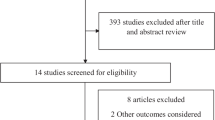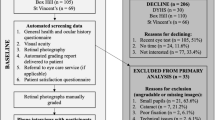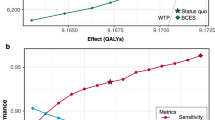Abstract
Objectives
The purpose of this study is to assess the accuracy of artificial intelligence (AI)-based screening for diabetic retinopathy (DR) and to explore the feasibility of applying AI-based technique to community hospital for DR screening.
Methods
Nonmydriatic fundus photos were taken for 889 diabetic patients who were screened in community hospital clinic. According to DR international classification standards, ophthalmologists and AI identified and classified these fundus photos. The sensitivity and specificity of AI automatic grading were evaluated according to ophthalmologists’ grading.
Results
DR was detected by ophthalmologists in 143 (16.1%) participants and by AI in 145 (16.3%) participants. Among them, there were 101 (11.4%) participants diagnosed with referable diabetic retinopathy (RDR) by ophthalmologists and 103 (11.6%) by AI. The sensitivity, specificity and area under the curve (AUC) of AI for detecting DR were 90.79% (95% CI 86.4–94.1), 98.5% (95% CI 97.8–99.0) and 0.946 (95% CI 0.935–0.956), respectively. For detecting RDR, the sensitivity, specificity and AUC of AI were 91.18% (95% CI 86.4–94.7), 98.79% (95% CI 98.1–99.3) and 0.950 (95% CI 0.939–0.960), respectively.
Conclusion
AI has high sensitivity and specificity in detecting DR and RDR, so it is feasible to carry out AI-based DR screening in outpatient clinic of community hospital.
Similar content being viewed by others
Login or create a free account to read this content
Gain free access to this article, as well as selected content from this journal and more on nature.com
or
References
Yau JW, Rogers SL, Kawasaki R, Lamoureux EL, Kowalski JW, Bek T, et al. Global prevalence and major risk factors of diabetic retinopathy. Diabetes Care. 2012;35:556–64.
Shaw JE, Sicree RA, Zimmet PZ. Global estimates of the prevalence of diabetes for 2010 and 2030. Diabetes Res Clin Pract. 2010;87:4–14.
Guariguata L, Whiting DR, Hambleton I, Beagley J, Linnenkamp U, Shaw JE. Global estimates of diabetes prevalence for 2013 and projections for 2035. Diabetes Res Clin Pract. 2014;103:137–49.
Song P, Yu J, Chan KY, Theodoratou E, Rudan I. Prevalence, risk factors and burden of diabetic retinopathy in China: a systematic review and meta-analysis. J Glob Health. 2018;8:010803.
Peng J, Zou H, Wang W, Fu J, Shen B, Bai X, et al. Implementation and first-year screening results of an ocular telehealth system for diabetic retinopathy in China. BMC Health Serv Res. 2011;11:250.
Gulshan V, Peng L, Coram M, Stumpe MC, Wu D, Narayanaswamy A, et al. Development and validation of a deep learning algorithm for detection of diabetic retinopathy in retinal fundus photographs. JAMA. 2016;316:2402–10.
Raju M, Pagidimarri V, Barreto R, Kadam A, Kasivajjala V, Aswath A. Development of a deep learning algorithm for automatic diagnosis of diabetic retinopathy. Stud Health Technol Inf. 2017;245:559–63.
Rajalakshmi R, Subashini R, Anjana RM, Mohan V. Automated diabetic retinopathy detection in smartphone-based fundus photography using artificial intelligence. Eye. 2018;32:1138–44.
Keel S, Lee PY, Scheetz J, Li Z, Kotowicz MA, MacIsaac RJ, et al. Feasibility and patient acceptability of a novel artificial intelligence-based screening model for diabetic retinopathy at endocrinology outpatient services: a pilot study. Sci Rep. 2018;8:4330.
Aldington SJ, Kohner EM, Meuer S, Klein R, Sjolie AK. Methodology for retinal photography and assessment of diabetic retinopathy: the EURODIAB IDDM complications study. Diabetologia. 1995;38:437–44.
Wilkinson CP, Ferris FL 3rd, Klein RE, Lee PP, Agardh CD, Davis M, et al. Proposed international clinical diabetic retinopathy and diabetic macular edema disease severity scales. Ophthalmology. 2003;110:1677–82.
Abramoff MD, Folk JC, Han DP, Walker JD, Williams DF, Russell SR, et al. Automated analysis of retinal images for detection of referable diabetic retinopathy. JAMA Ophthalmol. 2013;131:351–7.
Szegedy C, Ioffe S, Vanhoucke V, Alemi A. Inception-v4, inception-ResNet and the impact of residual connections on learning. 2016;arXiv preprint arXiv:1602.07261.
Rema M, Premkumar S, Anitha B, Deepa R, Pradeepa R, Mohan V. Prevalence of diabetic retinopathy in urban India: the Chennai Urban Rural Epidemiology Study (CURES) eye study, I. Investig Ophthalmol Vis Sci. 2005;46:2328–33.
Wong TY, Klein R, Islam FM, Cotch MF, Folsom AR, Klein BE, et al. Diabetic retinopathy in a multi-ethnic cohort in the United States. Am J Ophthalmol. 2006;141:446–55.
Sinclair SH. Diabetic retinopathy: the unmet needs for screening and a review of potential solutions. Expert Rev Med Devices. 2006;3:301–13.
Verma L, Prakash G, Tewari HK, Gupta SK, Murthy GV, Sharma N. Screening for diabetic retinopathy by non-ophthalmologists: an effective public health tool. Acta Ophthalmol Scand. 2003;81:373–7.
Philip S, Fleming AD, Goatman KA, Fonseca S, McNamee P, Scotland GS, et al. The efficacy of automated “disease/no disease” grading for diabetic retinopathy in a systematic screening programme. Br J Ophthalmol. 2007;91:1512–7.
Abramoff MD, Lou Y, Erginay A, Clarida W, Amelon R, Folk JC, et al. Improved automated detection of diabetic retinopathy on a publicly available dataset through integration of deep learning. Investig Ophthalmol Vis Sci. 2016;57:5200–6.
Gargeya R, Leng T. Automated identification of diabetic retinopathy using deep learning. Ophthalmology. 2017;124:962–9.
Ting DSW, Cheung CY, Lim G, Tan GSW, Quang ND, Gan A, et al. Development and validation of a deep learning system for diabetic retinopathy and related eye diseases using retinal images from multiethnic populations with diabetes. JAMA. 2017;318:2211–23.
Funding
This work was supported by Advanced and Appropriate Technology Promotion Project of Shanghai Health Commission (2019SY012), Project of Shanghai Municipal Commission of Health and Family Planning (201740001, 20164Y0180), Science and technology innovation action plan of Shanghai Science and Technology Commission (17411952900), Project of Shanghai Jing’an District Health Research (2016QN06, 2019QN07), Project of Shanghai Jing’an District Municipal Commission of Health and Family Planning (2018MS12, 2016084). Project of Shanghai Shibei Hospital of Jing’an District (2018SBMS10).
Author information
Authors and Affiliations
Corresponding author
Ethics declarations
Conflict of interest
The authors declare that they have no conflict of interest.
Additional information
Publisher’s note: Springer Nature remains neutral with regard to jurisdictional claims in published maps and institutional affiliations.
Rights and permissions
About this article
Cite this article
He, J., Cao, T., Xu, F. et al. Artificial intelligence-based screening for diabetic retinopathy at community hospital. Eye 34, 572–576 (2020). https://doi.org/10.1038/s41433-019-0562-4
Received:
Revised:
Accepted:
Published:
Issue Date:
DOI: https://doi.org/10.1038/s41433-019-0562-4
This article is cited by
-
Performance and limitation of machine learning algorithms for diabetic retinopathy screening and its application in health management: a meta-analysis
BioMedical Engineering OnLine (2025)
-
Use of Deep Neural Networks in the Detection and Automated Classification of Lesions Using Clinical Images in Ophthalmology, Dermatology, and Oral Medicine—A Systematic Review
Journal of Digital Imaging (2023)
-
Developments in the detection of diabetic retinopathy: a state-of-the-art review of computer-aided diagnosis and machine learning methods
Artificial Intelligence Review (2023)
-
Application of artificial intelligence-based dual-modality analysis combining fundus photography and optical coherence tomography in diabetic retinopathy screening in a community hospital
BioMedical Engineering OnLine (2022)
-
Cost-effectiveness of artificial intelligence screening for diabetic retinopathy in rural China
BMC Health Services Research (2022)



